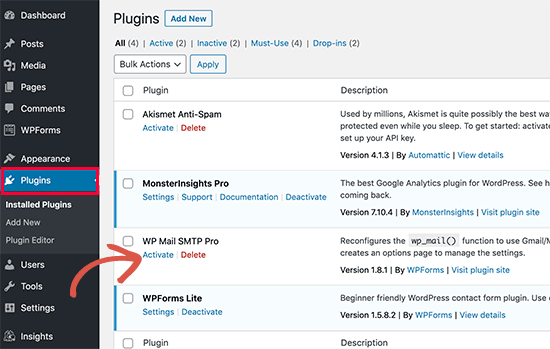Allow WordPress plugins via the dashboard. Select “Add New”, and after that, click on the add Plugin button. Simple plugins will automatically be activated however more complex plugins might require you to set them up prior to their use. For instance, if you have installed a plugin for a form it will offer forms templates, but you will need to alter the form templates. If you’d like for your site to be translated into another language then you’ll need to configure the translation plugin. If you’re not equipped with the required knowledge to do this it is possible to get in touch with the support department at the hosting provider to assist you.
You can also deactivate or activate the plugin in WordPress in case you do not possess admin rights. To enable a plugin you may either activate it via the database or in the WordPress administrator section. If you enable it through your database area, the plugin could not function as intended. It is therefore essential to be aware of how to use the database prior to making any modifications. Be sure to back up your database prior to making any changes. make any changes to ensure that you are prepared.
If you do not be able to access the administrator area of your plugin, you are able to manually edit the database of a plugin. However, you must know that it may create problems since the modifications you make won’t be saved when updates are made. If you decide to alter the database of your plugin it is possible to create backup copies of it by using the file manager. It’s useful for backups and in case something goes wrong, you could use this version.
How come I can’t install plugins on WordPress:
Table of Contents
Before you can enable a plugin it is essential to make sure that you are able to access the database. This is the same for deactivating an admin-only plugin. It is possible to enable the plugin via your database, but you have to be aware of what you’re doing and be cautious when you do it. If you aren’t able to change this setting it is recommended to start by backing up your database. Once you’ve done this you’ll be able to back up a copy of your database. If there’s a problem it’s possible to recover your website’s functionality.
Once you have your database, you will need to install an application. After you have downloaded a plugin, you’ll need to activate it. Check to ensure that you’re using an appropriate plugin for your particular project. Once the plugin is installed, it is necessary to activate it in order to guarantee its effectiveness. It is also possible to deactivate a plugin at a later time. This will keep the plugin from affecting the layout of your website. It is necessary for downloading the zip file, then add it to the WordPress install directory.
How To Display Plugins In the WordPress Page:
When you’re running an extension plugin, it is possible to deactivate it by altering the database. The information can be found in the database of the plugin. You can also disable it through the database. The database is a complete source of details regarding the plugin. You can either remove it or alter it as you need to. Then, you can continue to use WordPress. It’s not difficult to deactivate the plugin after you have removed it.
Once you’ve activated an extension, you’ll have to upload it onto Your WordPress installation. To accomplish this, you’ll need to make use of using the FTP command. By doing this you’ll be able to access the files in your WordPress installation. This command will allow or deactivate the plugin. If you’re new to the game or a novice, you can turn it on by hand. You may also follow an instructional video to enable the plugin. It is necessary to duplicate the plugin code into your database.
How to Install WordPress Plugin from zipping:
After you’ve downloaded and installed an application, you’ll need to activate it. It is necessary in order to set up the plugin for your website. You’ll have to select an appropriate folder within the directory of the plugin and then enter the PHP My Admin password. If you do not already have FTP access, you’ll need to use phpMyAdmin from your local PC. You’ll require the SFTP credentials for the WordPress setup to download the plugin.
To activate a plugin in WordPress:
Log into WordPress.
Visit Plugins > Installed Plugins.
Select the plugin that you want to activate.
Click on Activate.
For installing a plug-in you will need to visit the directory of plugins in the plugin directory of your WordPress installation. You’ll need access to the database in order to enable the plugin. After you’ve completed this you can select”Add Plugin” and then click the “Add Plugin” button to activate the plugin. Once you’ve done that, you’ll need to modify the settings. When you’re using a customized plugin, you’ll need to select the correct directory for it to function. It’s not required to erase your entire directory.

